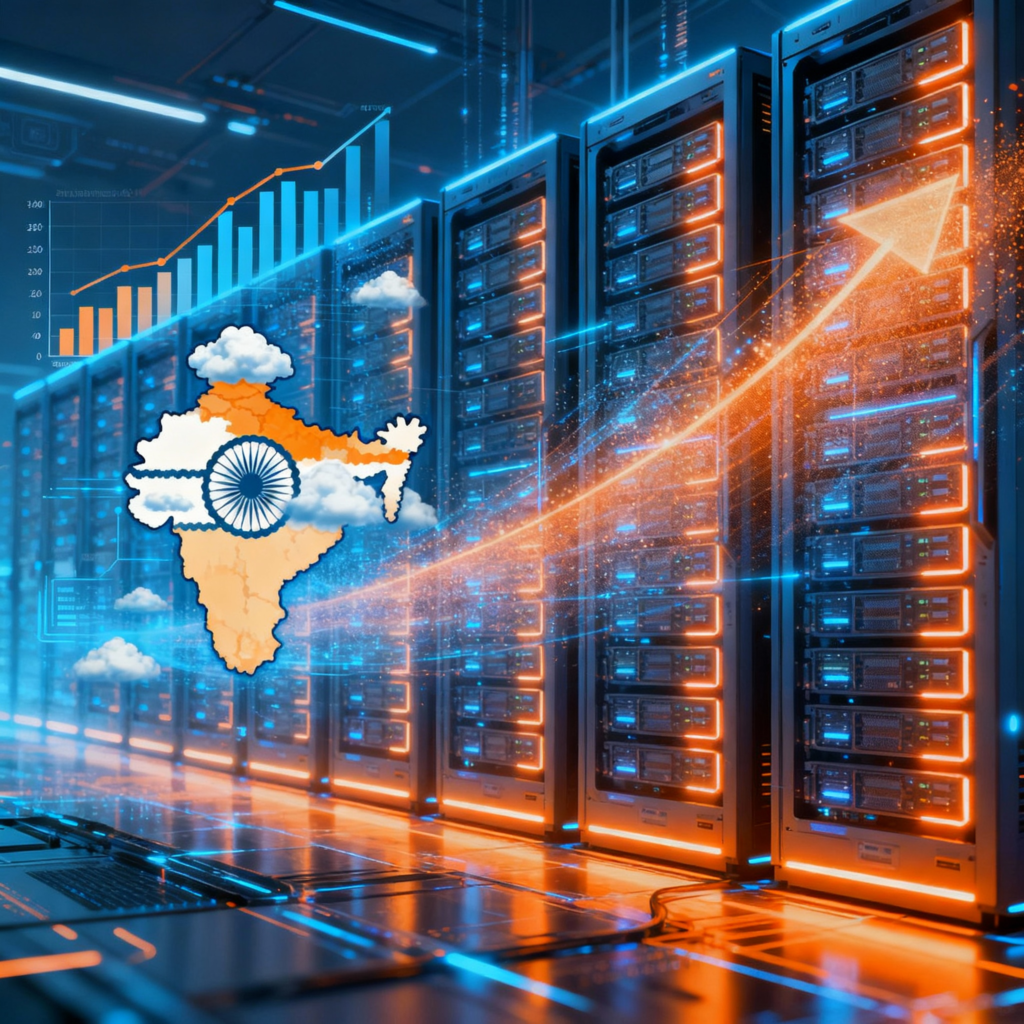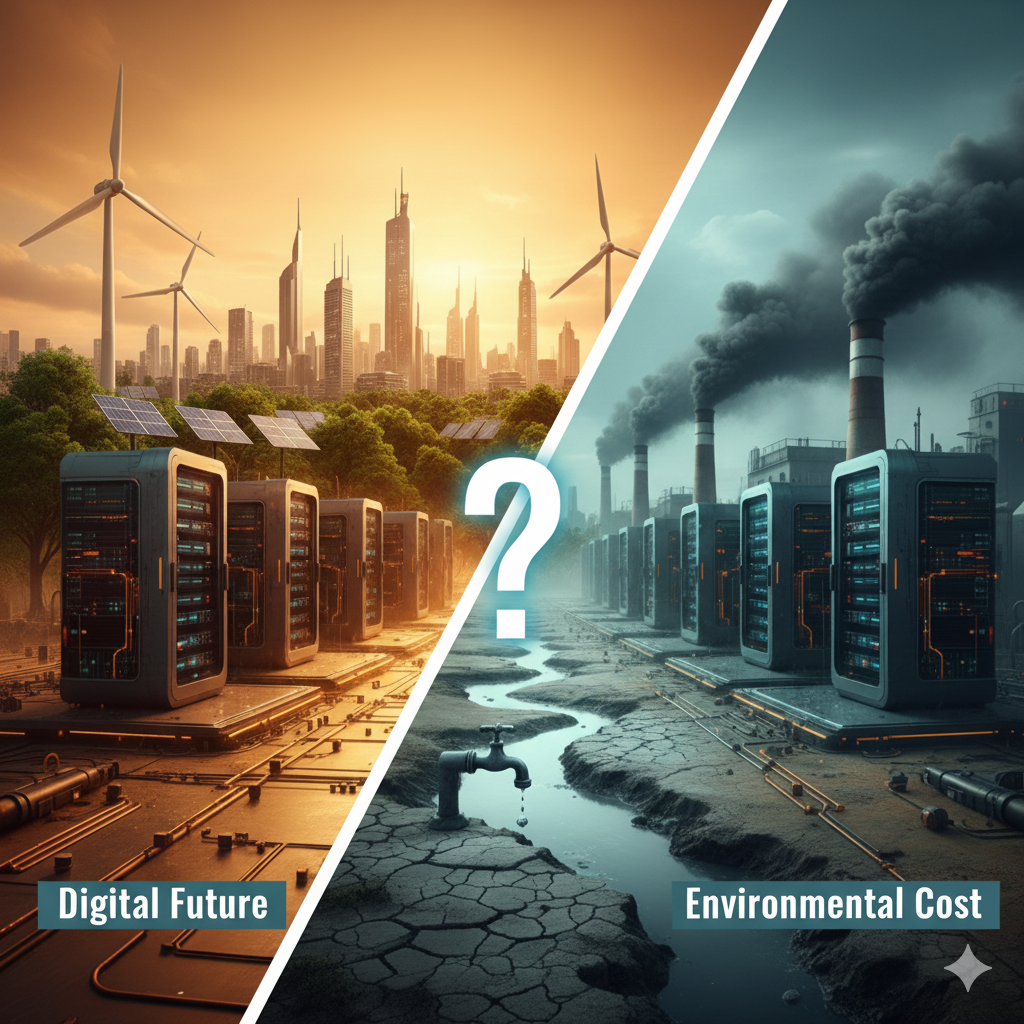Key Highlights
Explosive Growth Trajectory: India’s data centre capacity set to double by 2027 to 2.8 GW and potentially reach 7 GW by 2030, driven by $30-45 billion in cumulative investments
Gigascale Commitments: Google investing $15 billion in Visakhapatnam AI hub; TCS committing $6.5 billion for 1 GW network; AWS pledging $13 billion for cloud expansion; Reliance partnering with Meta and Google for green AI data centres in Jamnagar
Energy Demand Surge: Data centres projected to consume 1.9-3.2% of India’s national electricity by 2030 (up from 0.8% in 2024), requiring additional 15-30 GW capacity
Water Crisis Looming: Data centres need 25-68 million litres per MW annually; expansions in water-stressed Mumbai, Chennai, and Bengaluru risk operational disruptions without alternative cooling technologies
Policy Imperative: Urgent need for comprehensive National Data Centre Policy addressing sustainability, water use, power provisioning, and environmental standards amid fragmented state-level regulations
A Digital Infrastructure Revolution Unfolds
India stands on the precipice of a digital transformation so profound that it could redefine the nation’s technological landscape entirely. According to Macquarie Equity Research’s landmark report titled “Racks to Riches: India Data Centres,” the country’s data centre capacity is poised to double by 2027 based on current construction projects and potentially grow fivefold by 2030 if planned capacity materializes.
This isn’t mere incremental growth—it represents a fundamental reshaping of India’s digital infrastructure. Currently hosting 1.4 GW of operational data centre capacity, with another 1.4 GW under construction and approximately 5 GW in the planning stage, India is racing to establish itself as a global hub for cloud computing, artificial intelligence, and data processing. theweek

The momentum behind this expansion comes from an extraordinary convergence of factors: data localisation mandates compelling companies to store Indian user data within national borders, supportive government policies offering infrastructure status and subsidies, and explosive growth in cloud adoption across enterprises. Major tech giants are placing multibillion-dollar bets on India’s digital future, signaling confidence in the nation’s trajectory.
Gigascale Investments: Tech Titans Commit Billions
Google’s AI Infrastructure Hub
In October 2025, Google announced its largest-ever investment in India—a staggering $15 billion commitment over five years (2026-2030) to build an AI infrastructure hub in Visakhapatnam, Andhra Pradesh, in partnership with Adani Group.

This landmark project comprises a gigawatt-scale data centre campus, a new international subsea cable gateway connecting India’s eastern coast to Google’s global network, clean energy generation partnerships, and fiber-optic network expansion. The facility will power demanding AI workloads and host Google’s proprietary models including Gemini, Imagen, and Veo alongside platforms for custom AI agent development.
Employment projections are impressive, with estimates ranging from 180,000 total jobs when considering direct data centre operations, construction, power systems, fiber infrastructure, and higher-skill AI roles. The project positions Visakhapatnam as a digital gateway to Southeast Asia, leveraging the city’s access to undersea cable landing stations—a natural advantage for large-scale data centre deployment.
TCS’s Sovereign Data Centre
Tata Consultancy Services unveiled an ambitious plan in October 2025 to invest $6.5 billion over 5-7 years to build a 1 GW data centre network in India through a newly created wholly-owned subsidiary.
This investment is structured around approximately $1 billion per 150 MW of compute power, funded through a combination of equity and debt with financial partners. The strategic focus centers on “sovereign” AI data centres where all data and computing will be hosted within India’s borders, aligning with data localisation mandates.
Target clients include pure-play AI startups, deeptech companies, hyperscalers, and importantly, government entities and large Indian enterprises requiring in-country data residency. Revenue from TCS’s AI data centre operations is expected to begin accruing in 18-24 months.
AWS’s Cloud Expansion
Amazon Web Services committed $13 billion (revised from initial $12.7 billion announcements) to expand its India cloud infrastructure by 2030. The investment will support over 130,000 full-time equivalent jobs annually spanning construction, engineering, telecommunications, and cloud operations.
AWS currently operates two infrastructure regions in India—Mumbai (launched 2016) and Hyderabad (launched 2022)—and has trained over four million people in cloud skills since 2017. The expanded infrastructure will power enterprise and public sector adoption of generative AI tools including Amazon Q Business, Bedrock, and SageMaker.
A previous $8.3 billion AWS investment in Maharashtra is projected to create over 81,000 jobs annually and contribute approximately $15 billion to India’s GDP by 2030. The AWS Marketplace launch in India expected by late 2025 could reshape enterprise software procurement.
Reliance’s Green AI Data Centre Partnership
Reliance Industries launched Reliance Intelligence, a new wholly-owned unit partnering with Meta and Google to build gigawatt-scale, AI-ready data centres in Jamnagar powered by green energy.
The joint venture with Meta received an initial investment of $100 million to develop Llama-based AI platforms and enterprise tools tailored for Indian businesses. The partnership with Google will bring a dedicated Jamnagar Cloud region powered by Reliance’s renewable energy and connected through Jio’s advanced network.
This infrastructure will support both domestic AI growth and India’s ambitions to become a global AI hub, with phased rollouts tied to India’s AI demand growth.
Strategic Drivers: Why India, Why Now?
Data Localisation and Regulatory Framework
India’s data localisation laws have become a primary driver of data centre expansion. The Digital Personal Data Protection Act (DPDP) 2023 reiterates requirements that Sensitive Personal Data (SPD) including health, financial, and biometric information must be stored within India, with transfers abroad permitted only under strict conditions.
Critical Personal Data (CPD)—yet to be officially defined but pertaining to data crucial for national security—must be stored and processed exclusively within India with no transfers abroad allowed. Draft rules released in January 2025 expand government authority over cross-border data transfers, though critics note excessive executive discretion and trade-restrictive approaches. techpolicy
Sectoral regulations complement the overarching framework. The Reserve Bank of India mandated in 2018 that all financial data for Indian users must be stored domestically. Similar requirements affect payment system operators and various government agencies.
Government Support and Infrastructure Status
A landmark 2022 policy move granting “infrastructure status” to data centres opened floodgates for low-cost financing and simplified regulatory clearances. This classification ensures data centres are treated as essential services with access to priority power supply, streamlined land acquisition, and targeted financial incentives.
Multiple Indian states have introduced dedicated data centre policies. Maharashtra allows developers to apply for deemed distribution licensee or distribution franchisee status for direct power procurement. Uttar Pradesh offers similar provisions. The central government is drafting a comprehensive National Data Centre Policy to provide uniform regulatory clarity.
Surging Cloud Adoption and AI Expansion
Enterprise cloud adoption is accelerating across Indian industries, creating insatiable demand for computing and storage capacity. The overall India public cloud services market is expected to reach $13 billion by 2026, according to researcher IDC.
The advent of artificial intelligence dramatically amplifies infrastructure requirements. The Indian government has awarded 34,317 GPUs to data centres; once operational, they’ll need approximately 2 TWh of additional power, contributing significantly to rising demand. AI servers consume up to 10 times more power than standard servers, with Nvidia’s roadmap projecting rack power densities rising to 180 kW with the Rubin platform and further to 360 kW with Vera Rubin. nuclearbusiness-platform
Strategic Importance
National Security and Data Sovereignty
Data centres represent critical infrastructure for national security in the digital age. Storing sensitive government, defense, and citizen data within national borders reduces exposure to foreign surveillance and ensures law enforcement access during investigations.
The concept of “sovereign cloud”—computing infrastructure entirely within India’s jurisdiction—has gained prominence. TCS’s sovereign data centre network specifically targets government entities requiring assured data residency and secure AI infrastructure. This aligns with broader Atmanirbhar Bharat objectives of technological self-reliance.
Fiscal Impact and Economic Multipliers
Macquarie’s report projects cumulative capital expenditure between $30-45 billion (excluding servers) over the next five years for data centre development. Using cost estimates ranging from $4-7 million per MW cited in various project announcements, this represents one of the largest infrastructure investment waves in India’s tech sector.
These investments generate substantial economic multipliers. AWS’s commitment alone is projected to support 131,700 full-time jobs annually and contribute $15 billion to India’s GDP by 2030. Google’s Visakhapatnam project estimates 180,000 total employment opportunities spanning construction, operations, and advanced AI roles.
Beyond direct effects, data centres catalyze ecosystem development including power infrastructure, telecommunications networks, real estate, and specialized technical services.
Energy Security and Grid Management
The forecast that data centres will consume 1.9-3.2% of India’s national electricity by 2030, up from 0.8% in 2024, carries profound implications for energy planning.
India’s data centres are projected to become the second-largest electricity consumers in Asia-Pacific by 2030, surpassing Japan and Australia. Power demand is expected to surge from 13-17 TWh in 2024 to 57 TWh by 2030, representing a 28% annual growth rate.
Meeting this demand will require an additional 15-30 GW of power capacity dedicated to data centres by 2030, representing approximately 10% of India’s planned renewable energy additions. The challenge is compounded by AI’s exponential energy appetite—Goldman Sachs projects data centre power usage will increase 160% globally by 2030 driven by energy-intensive AI workloads.
Regional Distribution and Urban Infrastructure Challenges
Mumbai and Chennai: Dominant but Strained Hubs
Mumbai currently accounts for 40-45% of India’s total data centre capacity, with operational capacity slightly exceeding that of Hong Kong and Seoul. Chennai ranks second with 18-20% of installed capacity, followed by Delhi NCR at 11-14%.
These concentrations reflect strategic advantages: Mumbai’s position as India’s financial capital with extensive banking and finance sector presence, proximity to submarine cable connectivity at landing stations, and established telecommunications infrastructure. Chennai benefits from similar submarine cable access and robust IT ecosystem.
However, this concentration creates acute pressure on urban resources. Mumbai is adding another 1.1 GW capacity despite already strained infrastructure. Nearly 90% of India’s total data centre capacity resides in Mumbai, Chennai, and Delhi-NCR, intensifying localized environmental stress.
Water Stress: The Hidden Crisis
Data centres consume enormous volumes of water for cooling—a commonly cited figure suggests 25-68 million litres per 1 MW load annually depending on cooling technology.

Macquarie’s report warns that “data centres consume large volumes of water for cooling. With expansions planned in water-stressed cities such as Mumbai, Chennai and Bangalore, summer shortages could disrupt operations unless alternative cooling technologies or government interventions are implemented”.
The scale is staggering: a 20 MW data centre using water-intensive cooling could require approximately 1.37 million litres daily. Mumbai’s daily water supply totals just over 3,000 million litres with demand pegged higher; Chennai supplies approximately 1,000 million litres daily; Bengaluru provides about 1,500 million litres daily.
A 2021 Nasscom report classified water shortage as a high-risk factor for data centres in Chennai, Bengaluru, Hyderabad, and Delhi, with moderate-to-high risk for Mumbai. India’s data centre water consumption is estimated at 150.30 billion litres in 2025, projected to reach 358.66 billion litres by 2029.
Research indicates AI data centres can consume upwards of 15 million litres of high-quality portable water daily to prevent corrosion and microbial buildup in machinery. Training GPT-3 in Microsoft’s US data centres directly evaporated an estimated 700,000 litres of clean freshwater.
Land and Power Provisioning Constraints
Urban land availability presents another bottleneck, particularly in Mumbai where real estate costs rank among the world’s highest. Data centres require substantial continuous land parcels with geological stability, flood protection, and seismic resilience.
Power provisioning challenges are multifaceted. Transmission infrastructure often lags behind generation capacity, creating bottlenecks in bringing new power online. In the US context, Goldman Sachs notes 5-7 year timelines for operationalizing and connecting new natural gas plants to grids due to permitting, transmission, and critical supply chain challenges.
India faces similar obstacles compounded by the need to balance fossil fuel reliability with renewable energy commitments. While many operators commit to 100% renewable energy by 2030, intermittency and storage limitations require careful grid management.
Opportunities and Risks: A Balanced Assessment
Economic Growth and Job Creation
The data centre boom promises substantial economic dividends. Beyond the $30-45 billion capex projected for infrastructure, operational spending creates sustained demand for skilled professionals, energy, telecommunications, and support services.
Job creation spans multiple skill levels: construction workers, electrical engineers, HVAC specialists, network administrators, cybersecurity experts, cloud architects, and AI specialists. Google’s Visakhapatnam project alone estimates 180,000 employment opportunities.
For India’s burgeoning tech ecosystem, domestic data centre capacity reduces latency, improves service quality, and enables startups to scale without dependence on foreign infrastructure. This supports Make in India and Digital India initiatives.
Environmental Stress and Sustainability Concerns
The environmental implications cannot be ignored. Data centres globally now consume 1-1.5% of all electricity and contribute 0.3% of global emissions—figures projected to reach 8% of global energy by 2030 if unchecked.
Sustainable data centres leveraging renewable energy for operations
A 1 MW data centre powered by thermal power can emit 8,760 metric tons of CO₂ annually, equivalent to emissions from over 1,900 cars. Water consumption threatens local watersheds, particularly during summer shortages when data centre demand conflicts with residential and agricultural needs.
Cooling water disposal raises additional concerns about thermal pollution affecting aquatic ecosystems. The carbon and water footprint are often at odds—optimizing one can hurt the other, necessitating holistic co-optimization approaches.
Resilience and Compliance Frameworks
Robust data centre operations require comprehensive disaster recovery, data protection, and compliance frameworks. India’s location exposes facilities to monsoons, cyclones, earthquakes, and extreme heat events—all requiring resilient design.
Data protection regulations under the DPDP Act impose obligations for breach notification, security audits, and consent management. Significant Data Fiduciaries face enhanced requirements including data protection impact assessments and appointment of Data Protection Officers.
Policy Recommendations: Building Sustainable Digital Infrastructure
Comprehensive National Data Centre Policy
India urgently needs a holistic data centre policy addressing water use, land allocation, power provisioning, and environmental standards. Current fragmented state-level policies create regulatory complexity.
The draft National Data Centre Policy should mandate sustainability benchmarks, establish certification standards for green data centres, provide clear guidelines for resource allocation in water-stressed cities, and create incentives for adoption of water-efficient cooling technologies.
The Indian Green Building Council’s (IGBC) August 2024 guide for certifying green data centres provides a foundation, including benchmarks for sustainable infrastructure, renewable energy usage, and energy efficiency. Expanding and mandating these standards would drive sector-wide improvement.
Public-Private Partnerships for Innovation
Collaboration between government, data centre operators, utilities, and technology providers can accelerate sustainable solutions. PPPs can facilitate large-scale renewable energy procurement, shared cooling infrastructure in industrial parks, R&D into advanced cooling technologies, and workforce training programs.
Companies like AWS, Sify Technologies, Nxtra, AdaniConneX, and CtrlS are already procuring renewable energy and establishing green data centres. Government support through streamlined renewable energy procurement, grid connectivity for renewable projects, and financial incentives for sustainability investments would amplify these efforts.
Mandating Green Technologies and Water Efficiency
Policy should mandate adoption of water-efficient cooling alternatives in water-stressed regions. Technologies include liquid cooling systems using significantly less water, air cooling suitable for moderate climates, immersion cooling submerging servers in dielectric fluids, and using treated wastewater (gray water) for cooling at cheaper costs than portable water.
Mandating Power Usage Effectiveness (PUE) targets—the ratio of total facility energy to IT equipment energy—would drive efficiency. Leading data centres achieve PUE values of 1.1-1.2 compared to industry averages of 1.5-1.6.
Water Usage Effectiveness (WUE) metrics should be tracked and reported, measuring litres of water consumed per kilowatt-hour of IT equipment energy. Transparency in resource consumption enables benchmarking and continuous improvement.
Capacity Building and Skills Development
The rapid expansion requires massive workforce upskilling. Educational institutions must develop specialized curricula covering data centre design, operations, energy management, and sustainability.
Certifications in data centre technologies, cloud platforms, and renewable energy systems should be promoted. Collaborations between industry and academic institutions can ensure training aligns with sector needs.
Government programs like Skill India should incorporate modules on data centre operations and maintenance. This creates employment pathways for youth while ensuring the sector has necessary talent.
Way Forward: Balancing Ambition with Responsibility
Short-Term Priorities (2025-2027)
Immediate action is essential as under-construction capacity comes online. Governments must accelerate approval processes for renewable energy projects dedicated to data centres. Establishing clear timelines and single-window clearances would reduce delays.
Pilot projects testing advanced cooling technologies in Indian conditions should be incentivized. Collaborations with global leaders in sustainable data centre design can transfer best practices.
Water allocation frameworks for data centres in stressed cities must be formalized, potentially including mandatory use of recycled water, phased expansion linked to water availability, and investments in desalination or water recycling infrastructure.
Medium-Term Goals (2027-2030)
By 2030, India should aim for majority renewable energy powering data centres, ideally exceeding the 50% global projection. This requires dedicated grid capacity, battery storage solutions, and hybrid renewable systems combining solar, wind, and hydro.
Decentralization of data centre capacity to Tier-2 cities like Bhubaneswar, Patna, Jaipur, and Coimbatore reduces pressure on Mumbai and Chennai while driving regional development. Edge data centres—smaller, modular hubs reducing latency—should be deployed strategically.
Domestic manufacturing capability for data centre components including servers, cooling systems, power infrastructure, and networking equipment must be developed to reduce import dependence and create local value.
Long-Term Vision (Post-2030)
India should aspire to become a global leader in sustainable data centre operations, exporting expertise and technologies. This requires sustained R&D investment, international collaboration, and demonstration of successful models balancing growth with environmental responsibility.
Nuclear energy may play a role in providing reliable, carbon-free baseload power for energy-intensive data centres. Small modular reactors (SMRs) offer flexibility and safety advantages suitable for dedicated industrial applications.
Ultimately, success requires recognizing that data centres are not mere infrastructure—they are enablers of India’s digital economy, determinants of technological sovereignty, and tests of our commitment to sustainable development.
Conclusion: The Digital Tightrope
India stands at a defining moment. The data centre boom represents an extraordinary opportunity to cement the nation’s position as a global digital powerhouse, create hundreds of thousands of jobs, attract tens of billions in foreign investment, and enable the next generation of cloud computing and artificial intelligence applications.
Yet this opportunity comes tethered to profound risks. Water-stressed cities already struggling to meet residential demand cannot endlessly absorb the needs of facilities consuming millions of litres daily. Power grids stretched by industrial growth and summer heat waves face exponential new demands just as India commits to renewable energy transitions.
The path forward demands more than technological prowess—it requires wisdom, foresight, and courage to make difficult choices. We must mandate efficiency standards even when they increase costs. We must decentralize capacity even when Mumbai’s connectivity advantages beckon. We must invest in renewable energy infrastructure even when natural gas offers easier short-term solutions.
Most critically, we must recognize that data centres are not abstractions—they are physical infrastructure with concrete environmental footprints. Every gigawatt of capacity brings both promise and peril. The question isn’t whether India should pursue this expansion—economic imperatives and technological sovereignty demands make that inevitable. The question is whether we possess the collective will to do it sustainably.
The data centre boom will test India’s commitment to the Sustainable Development Goals, our seriousness about climate action, and our capacity to balance competing imperatives. Success will require unprecedented coordination between central and state governments, between public and private sectors, and between immediate economic gains and long-term environmental stewardship.
What’s your take on India’s data centre expansion? Can we truly balance growth with sustainability, or are we building today’s digital infrastructure on tomorrow’s environmental crisis? Share your thoughts, concerns, and solutions in the comments below. Let’s build a conversation about the future we want to create!







Nice content